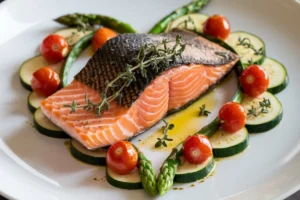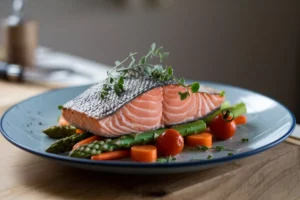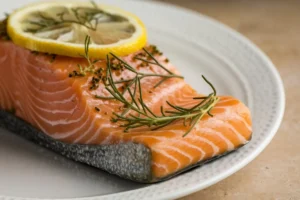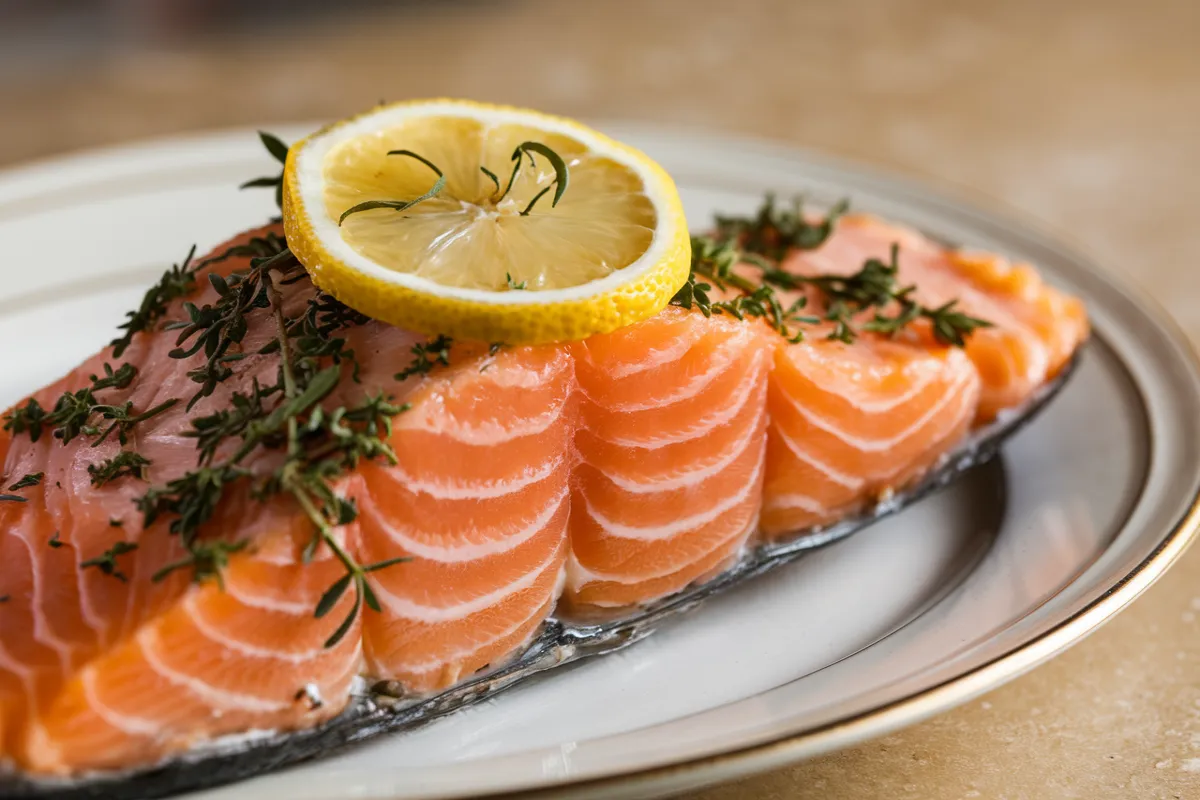Introduction to Gordon Ramsay’s Salmon Recipe
When it comes to culinary excellence, few chefs can match the reputation of Gordon Ramsay. Known for his fiery personality and unparalleled skill in the kitchen, Ramsay has become a global authority on fine dining and culinary arts. One of his most beloved dishes is his expertly cooked salmon. Whether it’s served in a fine dining restaurant or recreated in a home kitchen, Gordon Ramsay’s salmon recipe is an experience like no other.
But what exactly does Gordon Ramsay put on salmon to elevate it from a simple fish dish to a gourmet delight? In this blog, we’ll dive deep into his famous salmon preparation, examining the ingredients he uses, the techniques that make it perfect, and even how you can adapt it to your own kitchen. Along the way, we’ll explore why each component is important, how to master the cooking process, and various tips for getting it just right.
Let’s embark on this culinary journey and unravel the secrets behind Gordon Ramsay’s renowned salmon dish!
Ingredients and Components in Gordon Ramsay’s Salmon Recipe

Gordon Ramsay’s salmon is a symphony of flavors, textures, and aromas. While he’s known for his creative twists and bold flavor profiles, the core components of his salmon recipe remain relatively simple yet highly effective. Below is a breakdown of the primary ingredients Ramsay commonly uses to season and accompany salmon:
- Olive Oil: Extra virgin olive oil is used for both cooking the salmon and adding a final drizzle of richness to the dish. It brings out the natural oils in the fish and helps create that perfect sear.
Sea Salt & Freshly Ground Black Pepper:
- Ramsay keeps seasoning simple with just salt and pepper. He emphasizes the importance of seasoning both sides of the fillet generously before cooking to enhance the natural flavor of the salmon.
- Lemon Zest & Juice: Citrus is a key player in Ramsay’s salmon recipe, often used in both the marinade and the final garnish. The zest brings brightness and aromatic oils, while the juice adds a refreshing acidity that balances the richness of the fish.
- Herbs (Dill, Parsley, or Thyme): Fresh herbs are another Ramsay trademark. Dill and parsley are often featured due to their light, fresh flavors that pair well with fish. Sometimes, thyme is added for a slightly earthier flavor profile.
- Garlic & Shallots: For extra depth, Ramsay likes to incorporate finely minced garlic and shallots. These aromatics provide a savory foundation that complements the salmon without overpowering it.
- Butter: Ramsay is known for his mastery of rich, luxurious sauces, and butter is often used to finish his salmon dishes. Whether it’s melted into a sauce or used to baste the fillet during cooking, butter brings a silky texture and decadent taste to the dish.
- Vegetable Sides (Spinach, Asparagus, or Broccoli): Ramsay often pairs his salmon with fresh, seasonal vegetables. Lightly sautéed spinach, roasted asparagus, or steamed broccoli are common choices, offering a healthy and visually appealing contrast to the salmon’s rich flavor.
The Key Techniques Behind Ramsay’s Salmon Perfection

While the ingredients are essential, Gordon Ramsay’s success lies in his masterful cooking techniques. Below are the key methods Ramsay uses to cook salmon to perfection:
1. The Perfect Sear
Gordon Ramsay’s salmon is known for its crispy skin. The secret? Achieving the perfect sear. Here’s how he does it:
- Start with a hot pan: Ramsay always begins by heating the pan until it’s very hot. This helps to ensure that the skin crisps up quickly when it hits the pan, locking in moisture and flavor.
- Use minimal oil: Only a small amount of olive oil is needed to coat the pan. Too much oil can lead to soggy skin, while too little can cause sticking.
- Skin-side down: Ramsay always begins cooking the salmon skin-side down. The fish is gently pressed down with a spatula to ensure full contact with the hot pan, which helps create that coveted crispy skin.
- Don’t rush the flip: Allow the salmon to cook skin-side down for the majority of the time. Once the skin is crispy and golden, the fish is flipped and cooked for a brief moment on the flesh side.
2. Basting the Fish
Basting is another technique Ramsay employs to keep his salmon moist and flavorful. After flipping the salmon to the flesh side, he adds a knob of butter to the pan. As the butter melts, it is spooned over the top of the fish to infuse it with richness and moisture.
3. Oven Finishing
While some versions of Ramsay’s salmon dish are cooked entirely on the stovetop, he often finishes his salmon in the oven. This allows for even cooking, especially when working with thicker fillets. The salmon is transferred to a preheated oven for just a few minutes to reach the perfect internal temperature, resulting in a fish that is tender and flaky.
4. Resting the Salmon
One commonly overlooked step in cooking salmon is allowing it to rest. After removing the salmon from the heat, Ramsay lets it rest for a couple of minutes. This helps the juices redistribute throughout the fillet, ensuring that every bite is moist and flavorful.
Variations on Ramsay’s Salmon Recipe
Although the core elements of Gordon Ramsay’s salmon recipe remain the same, there are plenty of ways to experiment with this dish. Below are some popular variations:
- Honey & Soy Glazed Salmon: For an Asian-inspired twist, Ramsay sometimes incorporates a sweet and savory glaze made from soy sauce, honey, and ginger. This glaze caramelizes beautifully when cooked, giving the salmon a rich, sticky exterior.
- Herb-Crusted Salmon: Ramsay occasionally coats the salmon in a mixture of breadcrumbs, herbs, and Parmesan cheese for an extra crunchy texture and a punch of flavor.
- Mustard-Crusted Salmon: Another popular variation involves slathering the salmon in Dijon mustard before searing. This adds a tangy sharpness that pairs beautifully with the fish’s richness.
- Salmon en Papillote: For a more delicate preparation, Ramsay sometimes cooks his salmon en papillote (in parchment paper). This method steams the fish, resulting in an incredibly tender and flavorful dish, often paired with fresh vegetables and herbs.
Pairing Salmon with the Perfect Side Dishes
No great dish is complete without the right accompaniments. When it comes to salmon, Gordon Ramsay emphasizes the importance of pairing the fish with complementary flavors and textures. Here are some side dishes that are perfect with salmon:
- Sautéed Spinach: Ramsay often pairs his salmon with lightly sautéed spinach, which adds a vibrant green color and a slightly earthy flavor to the plate. A touch of garlic and olive oil enhances the spinach without overpowering the salmon.
- Roasted Asparagus: Asparagus is another favorite pairing with salmon. Ramsay roasts the asparagus in the oven with a bit of olive oil and sea salt until it’s tender yet still slightly crisp.
- Creamy Mashed Potatoes: For a heartier side, Ramsay sometimes serves his salmon with creamy mashed potatoes. This luxurious, buttery side dish complements the richness of the salmon and provides a comforting element to the meal.
- Quinoa Salad: For a lighter option, Ramsay might recommend a quinoa salad. Mixed with fresh herbs, cherry tomatoes, and a lemon vinaigrette, it adds a refreshing contrast to the richness of the fish.
- Garlic Green Beans: Crisp green beans sautéed with garlic and a touch of butter offer a crunchy, flavorful side that pairs well with salmon’s natural oils.
Common Mistakes to Avoid When Cooking Salmon
While Gordon Ramsay makes cooking salmon look effortless, there are several common mistakes that can ruin the dish if you’re not careful. Below are some tips to help ensure that your salmon turns out perfect every time:
- Overcooking the Salmon: Salmon is best when it’s slightly undercooked in the center. Overcooking can result in a dry, chalky texture. To avoid this, use a meat thermometer to ensure the internal temperature reaches around 125°F (52°C) before removing it from the heat.
- Not Patting the Salmon Dry: One of the keys to achieving crispy skin is starting with dry salmon. Use paper towels to thoroughly pat the fillet dry before seasoning and cooking.
- Skipping the Resting Period: As mentioned earlier, letting the salmon rest after cooking allows the juices to redistribute. Cutting into the fish immediately after cooking can result in a loss of moisture, leading to a dry fillet.
- Using Cold Salmon: Cooking salmon straight from the refrigerator can cause it to cook unevenly. Allow the fillet to come to room temperature for about 15 minutes before cooking to ensure even heat distribution.
Frequently Asked Questions

1. How do I know when my salmon is perfectly cooked?
The best way to check for doneness is by using an instant-read thermometer. Insert it into the thickest part of the salmon fillet. Salmon is perfectly cooked when it reaches an internal temperature of 125°F (52°C). The flesh should be opaque but still slightly translucent in the center, and it should flake easily with a fork.
2. Can I cook salmon without the skin?
While you can cook salmon without the skin, Gordon Ramsay prefers to leave the skin on as it helps protect the fish from overcooking and adds a delicious crispy texture when seared properly. If you prefer skinless salmon, you can still achieve a great result, but be extra careful not to overcook the fish.
3. What type of salmon should I buy?
Ramsay typically recommends wild-caught salmon for its richer flavor and firmer texture compared to farmed salmon. However, sustainably farmed salmon can also be a good option, especially if wild salmon is not available in your area. Look for fillets that are bright and vibrant in color, with a firm texture and no fishy smell.
4. How do I store leftover cooked salmon?
To store leftover salmon, allow it to cool completely before placing it in an airtight container. Refrigerate for up to two days. To reheat, gently warm the salmon in the oven at a low temperature or enjoy it cold in a salad or sandwich.
Conclusion
Gordon Ramsay’s approach to salmon is a masterclass in simplicity and flavor. By focusing on high-quality ingredients, precise techniques, and a deep understanding of how to balance flavors, Ramsay elevates a humble fish into a world-class dish. Whether you’re preparing salmon for a special occasion or a weeknight dinner, following Ramsay’s tips will help you create a meal that’s both delicious and impressive.
From the perfect crispy skin to a luscious butter finish, Gordon Ramsay’s salmon recipe is a must-try for any food lover. The skills you’ll learn in this recipe—like mastering the sear, knowing when to finish in the oven, and understanding the importance of resting—will translate to countless other dishes. As you cook, you’ll gain confidence and a deeper appreciation for the art of culinary precision.
So, the next time you’re in the kitchen, channel your inner Gordon Ramsay, grab that salmon fillet, and get ready to wow your guests with a dish that embodies the best of modern fine dining.

